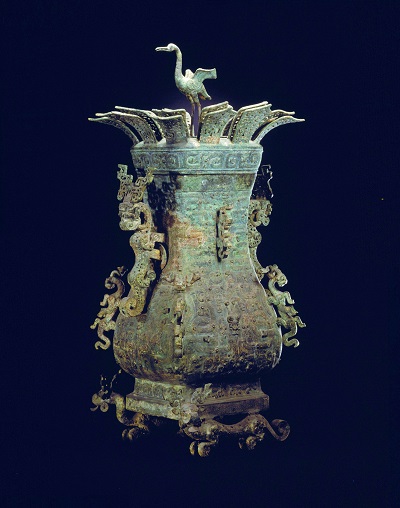Date: Spring and Autumn Period (770-476 BC)
Provenance: Excavated from the tomb of the Duke of Zheng, Lijialou, Xinzheng county, 1923
Measurements: Height: 117 cm, Length: 25 cm, Width: 31 cm
As a container for wine or water, the square jar (hu) has a rectangular mouth, long neck, tapering belly, and a square base. The lid of the jar is embellished with outspreading lotus petals arranged in two tiers along the edges, and a crane as the knob standing in the center.
The jar has a pair of dragon-shaped handles on two sides, and dragon patterns fully covering its belly. Each of the four folds of the jar is attached with a climbing dragon, each with its head turning back. Under the ring foot are two crouching mythical beasts, with their heads turned to one side and tongues sticking out, serving as the support of the vessel with their backs.
Crafted into an elegant shape with intricate patterns and exquisite craftsmanship, the vessel signifies a departure from the solemn and majestic style found in the bronze wares of the Shang (1600-1046 BC) and Zhou (1046-221 BC) dynasties, giving way to a representation that emphasizes dynamic posture and a sense of strength.
The crane on the lid is spreading its wings in the appearance of imminent flight, and the beasts on the body of the jar appear to be ascending the wall. Together, these images imbue the vessel with a captivating artistry that combines stillness and action with innovation, vibration, solemnity, and mysticism.
In the mid Spring and Autumn Period, with the weakening authority of the Zhou court, the vassal states were getting increasingly stronger, and the political system which took the "rites" as its governmental and cultural foundation gradually collapsed. The present vessel of this period reflects the zeitgeist of the age, characterized by ideological transformation and social upheaval.

